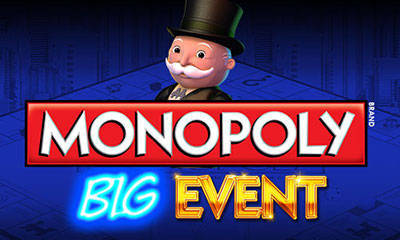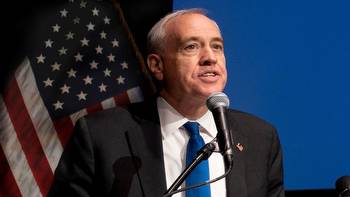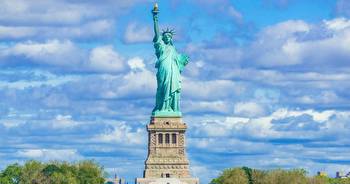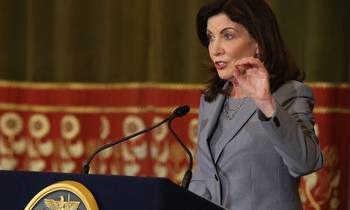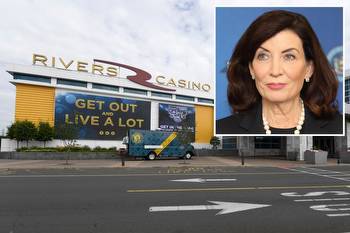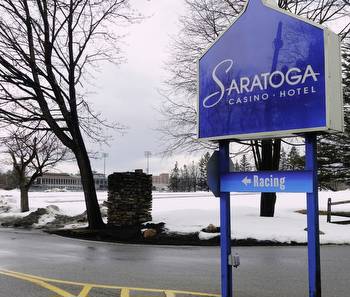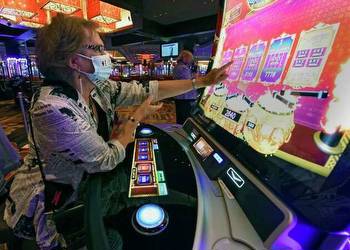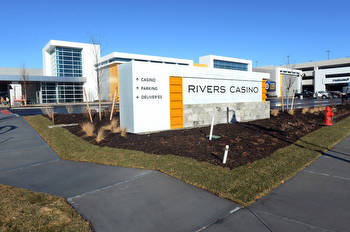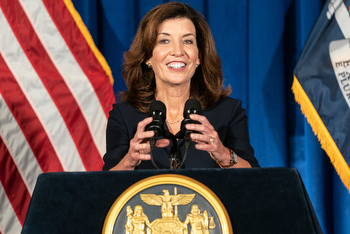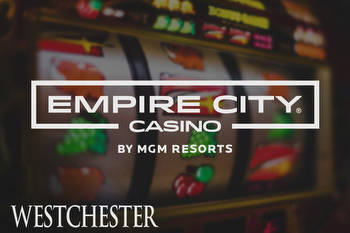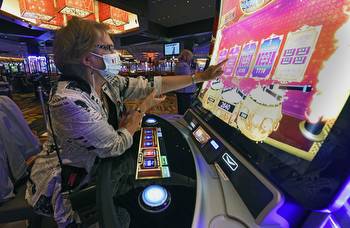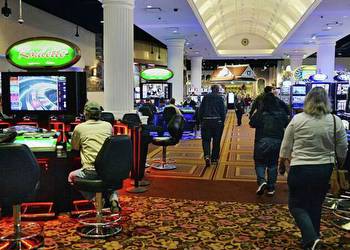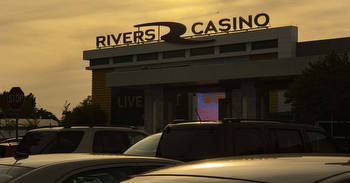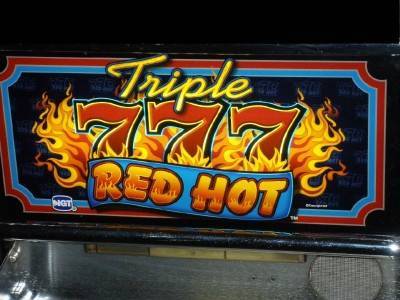Gambling industry conference comes to Saratoga amid proliferation of betting options
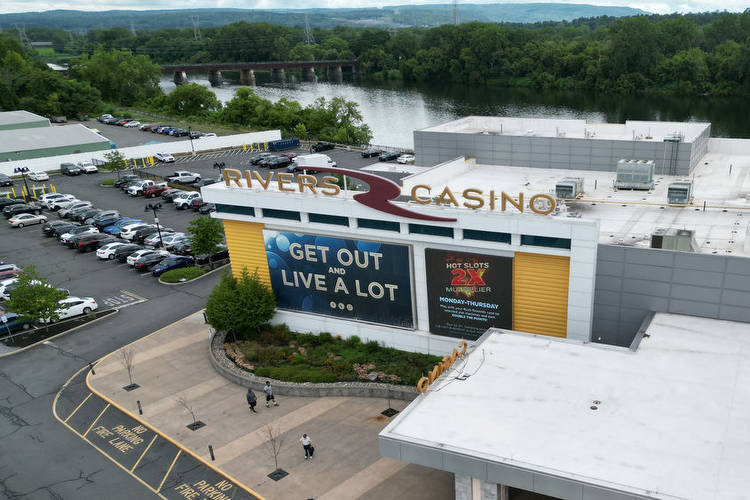
SARATOGA SPRINGS — The annual gaming and racing industry conference rolls into town this week as New Yorkers continue to spend more money on an ever-growing array of gambling options.
“It’s one of the most dynamic marketplaces in the country because there is this technological innovation, there is what I would describe as the societal acceptance of gaming and gambling,” said Patrick Brown, organizer of The Racing and Gaming Conference at Saratoga.
The veteran lobbyist noted that in the mid 20th century, New York allowed legal betting only on horse races and only in person. It gradually added a lottery, off-track betting, tribal casinos, video gaming casinos, four non-tribal casinos, sports wagering and, earlier this year, online sports wagering.
The licensing process will soon begin for up to three more non-tribal casinos in and near New York City, while proposals have been introduced in the Assembly and Senate to authorize online casino gambling.
The gambling industry in New York is actually multiple industries, Brown said — horse racing, on-site casinos and electronic wagering. They’ll all be covered at the three-day conference, as will efforts to prevent and treat the gambling addictions that advocates say are increasing as betting becomes easier and more accessible.
CASINOS
Casinos were banned in New York for decades, and reintroducing them was a dream held by some people and businesses for decades. The idea began to pick up momentum after the Great Recession, with advocates touting the value of keeping New Yorkers’ gambling dollars in this state and boosting the economy here, rather than seeing that money go elsewhere.
The state Legislature endorsed a constitutional amendment allowing up to seven casinos to open on non-tribal land. Voters approved it in 2013.
The first four non-tribal casinos opened upstate from December 2016 to February 2018.
Results were mixed but mostly positive — they created hundreds of millions of dollars worth of economic activity and thousands of jobs, as hoped, but not as much tax revenue as projected.
Positive and negative spinoff effects are harder to quantify but are real, with surrounding communities seeing more economic activity and more people losing money they can’t afford to lose.
In-person sports wagering began in New York casinos in 2019, but activity tapered off earlier this year as mobile sports wagering debuted in the state.
After a disastrous 2020-2021 fiscal year, thanks to COVID, the four non-tribal casinos saw record sums played in their slot machines, table games and card tables in 2021-2022: A combined $7 billion.
SCHENECTADY
Rivers Casino & Resort Schenectady has had some of the strongest financials among the four casinos so far, generating the most revenue per slot machine and, until receiving a COVID-related tax cut, generating the most gaming tax revenue.
Its workforce peaked at more than 1,000 before the pandemic hit and stood at 880 in mid-2022, with active recruiting underway for several dozen more employees.
Rivers generates millions of dollars per year for the city, county and school district in sales, gaming, property and hotel taxes; millions in gaming tax for seven nearby counties; and tens of millions for state-level education aid and property tax relief.
Before the pandemic, it was hosting more than 350 events a year and attracting more than 1.7 million guests.
And Rivers is the largest single piece of the half-billion-dollar redevelopment of a brownfield that previously held a crumbling locomotive factory.
Rivers is not, however, willing to share its assessment of the casino industry at the five-year mark for this story. Parent company Rush Street Gaming also declined comment.
In written comments to the state Gaming Commission in 2021, Illinois-based Rush Street enthusiastically supported the issuance of three more casino licenses downstate. It held up Rivers Schenectady as an example of a successful project that benefited its community, and indicated it was interested in securing one of the downstate licenses.
SARATOGA
Long before the four full-fledged casinos were built on non-tribal land in New York, video gambling halls were authorized at horse tracks around the state. The first to open was at the harness track in Saratoga Springs, in January 2004.
Saratoga Casino Hotel’s gross gaming revenue dropped 26% in three years after Rivers opened in February 2017, and has rebounded only slightly. But even so, more money is played on its video gaming machines than in the slot machines at Rivers or any of the three other non-tribal casinos.
Cash flow at the state’s video gambling facilities, in fact, far outstrips the non-tribal casinos: A whopping $38 billion was played last year in the ten video facilities statewide, compared with $7 billion at the four casinos.
Alex Tucker, chief operating officer of Saratoga Casino Hotel, said his facility weathered the major initial impact of Rivers’ grand opening in 2017 — a 30% drop in customer traffic — and has seen small improvements in each following year, save for COVID.
“We don’t believe that business will ever return to pre-competition levels, but the overall impact was actually less than we had anticipated,” he said via email.
Tucker doesn’t see the new casinos planned downstate as a threat at this point.
“We’re a local’s casino and we see the majority of our business coming from within less than a 75-mile radius, so we don’t anticipate more downstate casinos having a direct impact on our business,” he said.
Tucker also said the operation is not a stationary target for its competitors — it has continually updated and reinvested in the property over 18 years.
Most recently, the casino got an $11 million redesign of its gaming floor in 2021, renovated its hotel lobby, and this month is wrapping up completion of an outdoor pavilion with a lounge and games.
Parent company Saratoga Casino Holdings LLC is expanding its portfolio, as well. It already owns Saratoga Casino Black Hawk in Colorado, and expects to close on purchase of Magnolia Bluffs Casino in Mississippi later this year.
NEW YORK CITY
About 65% of all New Yorkers live in the compact 10-county zone that consists of New York City and its closest five suburbs, and six of those counties top the list of per-capita income among the state’s counties.
As many as three more casino licenses will be authorized in this zone, and the sums of money they could rake in is potentially enormous.
Guests played a combined $28.1 billion at the video gaming facilities located in and just north of New York City in 2021, quadruple the combined total played at the four upstate casinos.
Assemblyman J. Gary Pretlow, D-Mount Vernon, who chairs the Assembly Racing and Wagering Committee, said Resorts World at the Aqueduct race track in Queens and Empire City Casino at Yonkers Raceway are possibly the front-runners for two of the three new casino licenses.
These large video gaming facilities have a documented performance record, he said, and have demonstrated community support. With the physical infrastructure, personnel and knowledge they have in place, they could begin operations much more quickly than a new casino built from scratch.
This is a major advantage over competitors, though not a guarantee of victory, said Pretlow.
He’s not worried about any negative effects on the nation’s largest city once casinos are set up there.
“All the bad things people said would happen didn’t happen, I don’t think that’s going to change,” he said.
The situation is not perfect, Pretlow said. The full-line casinos, called “commercial casinos” by the industry and by New York state regulators, generate less money for education aid than video gambling facilities, for example. He’ll be sorry to see that revenue decrease if Resorts World New York City and Empire City convert to commercial casinos.
But he sees more friction for casinos proposed elsewhere — from likely strong pushback by community leaders against a casino in Manhattan; to accessibility issues at Citi Field, where the owner of the Mets has floated the idea of a casino; to the bad optics of putting a casino in the poorest county in the state, the Bronx.
TURNING STONE
The modern era of destination casinos in New York began in the summer of 1993 in Verona, midway between Utica and Syracuse, when the Oneida Indian Nation opened Turning Stone.
At the time, the nation’s representative told reporters it was a new chapter for a people deeply mired in poverty, but added that he wasn’t naive about its prospects: Indians never have anything valuable for very long, he said, before the white man wants a piece of it.
A dozen years later, the state licensed a video gaming casino at the Vernon Downs horse track, five miles away from Turning Stone. In 2017, two non-tribal casinos opened within easy driving distance — Del Lago in Waterloo and Rivers in Schenectady.
But Turning Stone has survived and thrived through that competition by being a destination that was more than a casino and by continuing to grow, said Joel Barkin, its vice president of communications. The most optimistic prediction when it opened in 1993 was that it would grow to 1,700 employees.
“Today we’re at 4,500 and we’ve been higher. We’re building back from COVID,” he said.
It faces the same challenge as other employers in a tight labor market, and is actively recruiting people in the Albany area to relocate to Verona, where rent-assisted housing awaits them as casino employees.
The Oneida Indian Nation calls Turning Stone the oldest and youngest casino in the state, given its continual expansion since 1993. There are now more than 20 restaurants, over 700 hotel rooms and five golf courses on site.
Turning Stone draws some guests from downstate but isn’t worried about losing them to new casinos; it’s worried about the market being saturated.
“We should not be creating new economic development models that undermine existing successful economic development models,” Barkin said. “You have to be very mindful of cannibalization. There’s a ton of proliferation across the Northeast right now.”
The Oneida Indian Nation has had its disagreements with state and local governments.
But the stakeholders have been on the same page for the last decade, Barkin said. The nation shares a minimum of $50 million in profits with the state and Madison and Oneida counties per year, and usually far more — $85 million total over the last four quarters.
For a host of reasons, tribal and non-tribal casinos can’t even be directly compared, he added.
“They’re two fundamentally different models,” Barkin said. “Our shareholders are right here in Central New York. They’re nation members. You’re not worried about sending profits out of town. The county never has to worry about us moving — they know we’re a captive industry.”
PROBLEMS ARISE
Amid all this talk of economies boosted and jobs created, the money lost and the lives damaged along the way are sometimes overlooked.
“The concern isn’t three new casinos or whatever. It’s more about the whole normalization of gambling as this normal behavior,” said Jim Maney, executive director of the New York State Council on Problem Gambling.
The council is officially neutral on the concept of casino gambling but can’t ignore some of the aspects that surround it. Advertising stands out as problematic, Maney said, particularly the ubiquitous mobile sports wagering ads.
“I don’t think there’s a person that hasn’t seen it. We’re very concerned about the marketing,” he said.
Signing up with an online sports wagering platform brings credits for free wagers, Maney said, wondering what the reaction would be if the same courtesy were extended for other addictive behaviors — say, free cigarettes or vodka on one’s 21st birthday.
“The availability of gambling is what increases problems,” he said, referring to the three new casinos planned in the most densely populated part of the state.
“The casinos for many, many people are something to do where there’s nothing else to do.”
The council operates seven resource centers from Long Island to Buffalo and with each successive expansion of gambling options in the state has seen an increase in the number and diversity of people looking for help with problem gambling, Maney said.
New York had allocated $5.7 million to problem gambling education and treatment and has dedicated $6 million a year from mobile sports wagering taxes to pay for education and treatment of problem gambling.
“The money that is allocated is not even close to enough,” Maney said.
He attends the Racing and Gaming Conference each year, as a listener rather than a speaker, and plans to be there this year, too. It will give him insight on the next stage of problem gambling, whether it be targeted marketing or betting windows at ballparks.
“It’s funny, you always learn exactly where they want to go,” he said of the industry.
CONFERENCE SET
The Racing and Gaming Conference at Saratoga will be Aug. 15-17 at the Saratoga Hilton. A highlighted presentation will be a panel discussion on the impending arrival of downstate casinos, moderated by Patrick Brown. Panelists will include Pretlow and former Gov. David Paterson, now a senior vice president at casino operator Las Vegas Sands.
Brown is a retired lobbyist whose clients included the developers of Rivers and del Lago casinos. He’s also a former professor at Albany Law School, which started the conference series two decades ago as an event for lawyers. When the school ended its sponsorship, Brown took it over and expanded its target audience and subject matter.
One of the topics covered this year will be horse racing in the metaverse. It’s a phenomenon Brown marvels at, resembling fantasy sports or NFT trading, and it’s growing rapidly.
“It’s like you’re creating a stable of horses in this virtual reality and you breed them, you train them, you feed them, you take care of them when they’re sick, and you race them. Real money is invested and spent on this,” he said.
Another panel topic — aftercare for race horses — is one that is dear to Brown, a thoroughbred owner.
“This is really an existential issue for the horse racing community,” he said, noting that racers retire by 6 or 8 years old but can live to be 30.
“You’ve got to have a system built into the market.”
Some of Brown’s retired horses have had second careers. One became an outrider, one of the non-racers that provide a calming presence when the racers are moving around at the track. But other horses need a whole new environment.
“You build relationships with after-care farms and you figure out what the best place is for the horse,” he said.
As for the still-growing number of places and ways to place a bet or wager money in New York, Brown doesn’t expect a consensus on how many is too many.
“You always have these discussions, sometimes arguments, about where the saturation point is,” he said.







